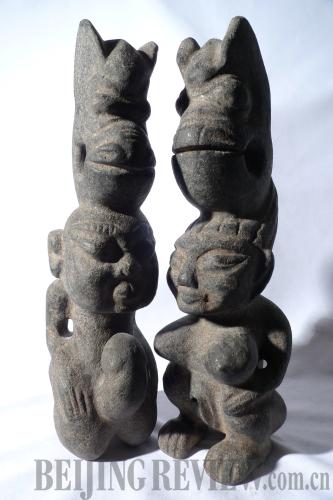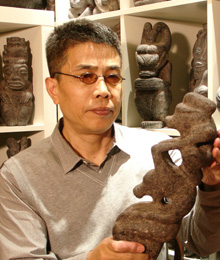|
 |
|
A pair of figure statuettes with bulging reproduction features (COURTESY OF ZHANG YIPING) |
 |
|
A MAN AND HIS TREASURES: Zhang Yiping handles a black-shelled jade sculpture at home (COURTESY OF ZHANG YIPING) | Everyone who has visited Zhang Yiping's secret chamber at his house is always astonished at the hundreds of mysterious jade sculptures he has collected over many years.
The Beijing resident has been engaged in collecting curios since the 1990s. Over two decades, he has stored up antiques including dark-red ceramic teapots and porcelain. However, what the collector treasures most is black-shelled jade sculptures, which he has extensively researched.
A lot of puzzles
One day in 1999, Zhang by chance stumbled across several black stone sculptures he had never seen at an antique market in Beijing. Even the seller failed to put a name to them.
"The sculptures resemble animal, human and abstract patterns, most coated with a black layer, which made it hard to tell they were jade," the collector told Beijing Review.
Zhang eventually decided to take the sculptures home for further research, finding they could be polished and the black shells consisted of two layers. The upper coating was formed by chemical reactions during a long period buried underground.
The second black layer resembled a type of artificial material. "Perhaps, this part was painted by ancient craftsman. But it is only my presumption," Zhang said.
After being polished, it soon became apparent the sculptures were made of jade. Due to a lack of evidence, it is still difficult to determine whether these sculptures are ancient curios or modern counterfeits. "However, the surface texture of the cleaned works carry the same veined characteristics as ancient jade ware," Zhang said.
Apart from their shells, the images and shapes of the sculptures are also extremely unique. "They are bold and bizarre," the collector stated.
"The animals, including turtles and night owls, were beautifully carved. Some images even showcase a combination of human bodies with animal heads, mostly that of an ox."
Despite every effort, Zhang's research initially revealed little as to the origins of these incredible works, further fueling his desire to unearth the real story.
| 